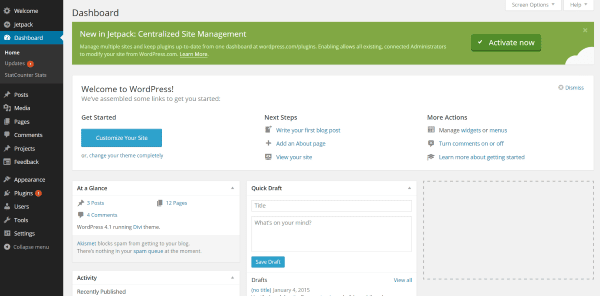Crafting Seamless Experiences: A Comprehensive Guide to Creating a Good User Experience (UX) in WordPress

Introduction:
In the vast and dynamic landscape of web development, crafting a compelling and user-friendly experience is paramount. For WordPress, the world’s most popular content management system (CMS), ensuring a good user experience (UX) is not just a best practice—it’s a fundamental goal. This comprehensive guide will delve into the principles, strategies, and tools for creating a good UX in WordPress, catering to beginners, seasoned developers, and anyone invested in delivering seamless online experiences.
I. Understanding User Experience (UX):
A. Defining UX: User Experience encompasses all aspects of a user’s interaction with a product, system, or service, and it focuses on ensuring a positive and meaningful experience. In the context of WordPress, UX involves the design, functionality, and overall satisfaction users derive from interacting with websites built on the platform.
B. Importance of UX: A good UX is critical for website success. It directly impacts user engagement, conversion rates, and overall satisfaction. By prioritizing UX in WordPress, developers and site owners can create an environment that is intuitive, accessible, and enjoyable for visitors.
II. Principles of Good UX in WordPress:
A. User-Centered Design: Place users at the center of your design process. Understand their needs, preferences, and behaviors to create a website that caters to their expectations. Conduct user research, gather feedback, and iterate on designs based on real user insights.
B. Clarity and Simplicity: Embrace simplicity in design. A clean and uncluttered interface with clear navigation enhances user comprehension. Avoid overwhelming users with unnecessary elements and prioritize a straightforward user journey.
C. Consistency: Maintain a consistent design throughout the website. Consistency in layout, color schemes, and navigation aids users in building a mental model of the site, making it easier for them to navigate and understand the content.
D. Accessibility: Ensure that your website is accessible to users of all abilities. Follow web accessibility standards (WCAG) to make content perceivable, operable, and understandable for everyone, including those with disabilities.
E. Responsive Design: Embrace responsive design to ensure your website adapts seamlessly to various devices and screen sizes. A mobile-friendly site is crucial for providing a positive UX across smartphones, tablets, and desktops.
F. Performance Optimization: Prioritize website performance for a smooth user experience. Optimize images, leverage browser caching, and minimize HTTP requests to reduce page load times. A fast-loading site contributes to user satisfaction and engagement.
III. Designing for a Good UX:
A. Intuitive Navigation: Design a clear and intuitive navigation structure. Users should easily find the information they seek without getting lost. Utilize a logical menu hierarchy, and consider implementing breadcrumbs for additional guidance.
B. Readable Typography: Choose legible fonts and maintain a readable font size. Consistent typography enhances the readability of your content, contributing to a positive user experience.
C. Engaging Visuals: Use high-quality images, graphics, and multimedia elements to enhance the visual appeal of your website. Visual content not only captures attention but also plays a crucial role in conveying information effectively.
D. White Space: Embrace white space in your design to prevent visual clutter. Adequate spacing between elements improves readability and allows users to focus on essential content.
E. Calls to Action (CTAs): Strategically place CTAs throughout your website to guide users toward desired actions. Use compelling language and design elements that stand out without overwhelming the overall interface.
F. Forms Optimization: Streamline form fields and minimize user input to reduce friction in interactions. Clearly label form fields, provide helpful hints, and implement error messages to assist users throughout the form submission process.
IV. WordPress Themes and Templates:
A. Choosing User-Friendly Themes: Opt for WordPress themes that prioritize user experience. Consider themes with customization options, responsive designs, and good accessibility features.
B. Customization Capabilities: Leverage WordPress’s customization features to tailor themes according to your brand and user preferences. Customize colors, fonts, layouts, and other elements to align with your site’s identity.
C. Theme Responsiveness: Verify that the selected theme is responsive across devices. Test the theme’s performance on various screen sizes to ensure a consistent and user-friendly experience.
D. Accessibility-Ready Themes: Explore themes that explicitly mention accessibility features. These themes adhere to accessibility standards, ensuring a better experience for users with disabilities.
V. WordPress Plugins for Enhanced UX:
A. Performance Plugins: Implement performance optimization plugins to enhance your website’s speed and responsiveness. Caching plugins, image optimization tools, and lazy loading plugins contribute to a faster user experience.
B. SEO Plugins: Enhance the discoverability of your content with SEO plugins. Yoast SEO and All in One SEO Pack are popular choices that provide tools for optimizing content, meta tags, and other SEO elements.
C. Security Plugins: Prioritize the security of your WordPress site with security plugins. Plugins like Wordfence and Sucuri Security offer features such as firewall protection, malware scanning, and login attempt monitoring.
D. Contact Form Plugins: Implement user-friendly contact forms using plugins like Contact Form 7 or WPForms. These plugins simplify the process of creating and managing contact forms, enhancing user communication.
VI. User Feedback and Testing:
A. User Testing: Conduct usability testing to gather insights from real users interacting with your website. Identify pain points, areas for improvement, and user preferences through hands-on testing sessions.
B. Feedback Forms: Implement feedback forms on your website to collect input from users. Encourage users to share their thoughts on the site’s design, functionality, and overall user experience.
C. Analytics and Data Analysis: Utilize web analytics tools like Google Analytics to track user behavior on your site. Analyze data such as bounce rates, page views, and user journeys to make informed decisions for UX improvements.
VII. Continuous Improvement:
A. Iterative Design: Embrace an iterative design process that involves continuous refinement based on user feedback and data analysis. Regularly revisit your site’s design, functionality, and content to implement improvements.
B. Regular Updates: Keep your WordPress installation, themes, and plugins up to date. Regular updates address security vulnerabilities, introduce new features, and contribute to overall performance improvements.
C. A/B Testing: Experiment with A/B testing to compare different versions of your site and identify the most effective design elements. Test variations in CTAs, layouts, or content to optimize for user engagement.
VIII. User Experience in WordPress Gutenberg Editor:
A. Block-Based Editing: Familiarize yourself with the Gutenberg block editor, introduced in WordPress 5.0. The block-based editing system provides a more visual and flexible approach to content creation.
B. Block Customization: Utilize the customization features within Gutenberg blocks. Adjust block settings, styles, and layouts to align with your site’s design and optimize for a better user experience.
C. Accessibility Considerations: Ensure your content remains accessible in the Gutenberg editor. Utilize semantic HTML, provide alternative text for images, and adhere to accessibility best practices for a universally inclusive experience.
IX. WordPress Multilingual and Global UX:
A. Multilingual Plugins: Implement multilingual capabilities using plugins such as WPML or Polylang to cater to a global audience. Translate content and provide localized experiences for users speaking different languages.
B. Localization: Prioritize localization efforts to adapt your website for different regions and cultures. Consider cultural nuances in design, content, and imagery to create a globally inclusive user experience.
C. Global Accessibility Standards: Adhere to global accessibility standards, such as WCAG, when designing and developing your WordPress site. Ensure that users from different regions and backgrounds can navigate and interact with your site seamlessly.
X. Community and Resources:
A. WordPress Community: Engage with the vibrant WordPress community for support, advice, and collaboration. Attend WordCamps, participate in forums, and contribute to the open-source ecosystem.
B. Online Documentation: Leverage the extensive online documentation provided by WordPress. The documentation offers guides, tutorials, and resources to assist users at various skill levels.
C. Continued Learning: Stay informed about the latest trends, tools, and best practices in UX design. Continuous learning ensures that you remain equipped to implement the most effective strategies for a positive user experience.
Conclusion:
In conclusion, creating a good user experience in WordPress is a multifaceted endeavor that involves a harmonious blend of design principles, functionality optimization, and user-centered strategies. From selecting user-friendly themes to implementing performance-enhancing plugins, the journey toward a seamless UX is dynamic and ever-evolving. Whether you’re a beginner navigating the intricacies of WordPress or a seasoned developer seeking to refine your site’s user experience, the principles outlined in this guide provide a roadmap for success. As we traverse the digital landscape, prioritizing the user experience in WordPress not only ensures visitor satisfaction but also contributes to the platform’s enduring legacy as a beacon of accessible and user-centric web development. So, embark on this journey of user-centric design, embrace the principles of good UX, and witness how WordPress becomes a canvas for crafting memorable and enjoyable online experiences.







